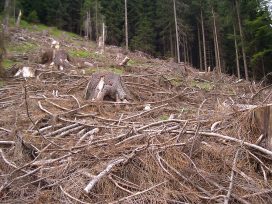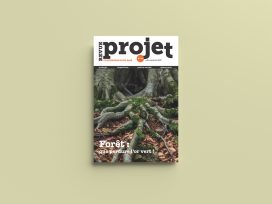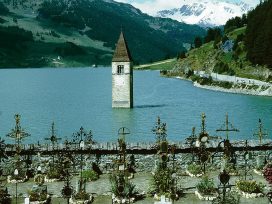That we humans – and I am above all referring to those of us living in the rich part of the world – need to radically change our approach to nature is becoming increasingly clear. The climate threat we face today calls for profound changes in ways of living and thinking. The West must reduce its greenhouse gas emissions by at least 80 per cent before 2050 in order to prevent global warming increasing more than two degrees over pre-industrial levels. This is the critical limit that most scientists agree we cannot transgress if we are to avoid the risk of large-scale changes occurring at such a rate that ecosystems will not be able to adapt.
The twentieth-century German philosopher Theodor W. Adorno seems a long way from this reality. His philosophy has often been criticized for leaving no room for practical intervention, his scepticism of collective effort in solving problems is widely known, and his aesthetics seems at first glance to be even further removed from the pressing environmental problems of today. He is often accused of elitism, and for advocating a form of high modernism long since outdated. Yet Adorno’s ideas on art and nature are extremely relevant in the search for new approaches to nature.
According to Adorno, the process of civilization is intertwined with separation from nature, with man’s departure from the immediate restraints imposed by nature. It is through the domination both of inner human nature (desires, needs) and outer non-human nature that man has been able to escape nature’s immediate hold. This domination is not, however, accomplished without repercussions for man himself. The increasing exploitation of nature has led to a society that is just as coercive as nature, itself the object of mastery. Western capitalist society has become a “second nature” exploiting the first.
A striking example of this is livestock farming, which according to the FAO (the Food and Agriculture Organization of the United Nations) is “one of the top two or three most significant contributors to the most serious environmental problems, at every scale from local to global”. The FAO reports that animal agriculture is responsible for 18 per cent of greenhouse gas emissions (far more than transport). So apart from the suffering (and premature death) of each individual animal, the constantly increasing production and consumption of meat also has an enormous negative impact on the environment.
Livestock farming also increases the risk for zoonoses (infections that can be transmitted from animals to humans) like the latest swine flu pandemic. In the global livestock industry, approximately 1.4 billion pigs are slaughtered annually for their meat. The farms where they are kept during their lifetimes contain thousands of animals. And thousands of genetically similar pigs in a small space make it easy for viruses to spread. So we have to manufacture a vaccine against swine flu. The vaccine is grown in hens’ eggs – on average, one egg per vaccine dose is needed. “A real global vaccination thus would require many billions of eggs and a production capacity that in practice doesn’t exist”, one reporter pointed out on the Swedish television series Vetenskapsmagasinet (The science magazine). At first I didn’t hear the “and” and started thinking about how many eggs the hens around the world lay each year. But of course the reporter was not referring to the hens’ capacity for producing eggs – we seem to think there is no limit to that. There are hens that have been bred to lay almost one egg per day. In Sweden alone, 100 000 tons of eggs are produced annually. If one egg weighs on average 55 grams, this amounts to 1.8 billion hens’ eggs annually. That represents two per cent of the total egg production in the EU, according to the Swedish trade association Svenska Ägg (Swedish Eggs). It was certainly not the production capacity of the hens that the reporter was referring to in Vetenskapsmagasinet.
Apart from being grown in hens’ eggs, the swine flu vaccine also contains squalene from sharks; the vaccine is also tested on animals. We truly do seem to be caught in a society built on “the perfected exploitation of the animal world”, as Adorno and Horkheimer write in Dialectic of Enlightenment.
But what we do to nature and the other animals, we also do to ourselves. The cure against the rigidification of second nature, against the deception of capitalism’s belief in perpetual growth at nature’s expense, is an acknowledgement of our own dependence on nature. In Dialectic of Enlightenment, Adorno and Horkheimer speak of a “remembrance of nature within the subject”. It is partly through philosophy, through a thinking that operates with what Adorno (inspired by Walter Benjamin) calls constellations, and partly through art, that this remembrance can be preserved. While Adorno, through his negative dialectics, tries to show the importance of “the priority of the object” before the idealistic notion of the constituting role of the subject in experience, he finds in art a sort of pain memory of the sensuous, a memory of how the priority of the object and the material – which originates in mankind’s dependence on nature – has been denied and repressed throughout history. In the early lecture “The idea of natural history”, Adorno on the one hand emphasizes the importance of breaking through what has petrified into second nature, and on the other the need to see nature itself as historical. Nature is more than what man makes it into when he perceives it as something opposite to himself and his making of history. It is the domination of nature, man’s mastery over nature, which turns it into something static and unchangeable: a perpetual repetition of the same course of events. What can be predicted can also be manipulated for one’s own profit: an approach to nature that in the end is detrimental to man himself. But art can offer a change of perspective.
According to Adorno, art is where nature is remembered, where the repression and denial of nature is remembered. Hence, art also points toward the possibility of a realized nature: in art we glimpse the freedom that could become reality if we acknowledged ourselves as part of nature. Nature and freedom are not complete opposites. Without acknowledgement of nature, freedom cannot be realized.
For this reason, Adorno is critical of both Kant’s and Hegel’s placement of man above nature. In Adorno’s opinion, the idea of man’s supremacy limits Kant’s philosophy and aesthetics. It is an idea that is reproduced in the German tradition after Kant. In Hegel it is manifested in the depreciation of natural beauty. Artistic beauty is ranked higher than natural beauty because it is more mediated by spirit or reason. Adorno’s attempt to reintroduce natural beauty into aesthetics is a corrective of sorts to the idealistic belief in the supremacy of human reason. However natural beauty must, he writes, be mediated through art in order to carry critical potential. Natural beauty is not an ahistorical aesthetic category; what we experience as beautiful or sublime in nature is historically conditioned and dependent on a high degree of domination. This is also clear in Kant’s notion of the sublime: we have to be at a safe distance from the forces of nature, we have to be free from the immediate restraints imposed by nature in order to be able to regard untamed nature aesthetically.
For that reason, Adorno considers uncritical enjoyment of nature to conceal the domination that is the prerequisite for this enjoyment. Adorno regards Kant’s account of the sublime as a description of natural beauty, well aware of the latter’s strict separation between the beautiful and the sublime. According to Adorno, the dynamic sublime and the opposition between man and nature that appears therein is a more adequate description of the aesthetic experience than the notion that it has to do with what is sensually pleasing. As with Kant, the sublime experience according to Adorno originates in a conflict between man and nature. But for Adorno, nature in itself is sublime. This is not the case in Kant, since if it were, his belief in the supremacy of reason would be undermined.
According to Adorno, the experience of natural beauty or the sublime is a question of nature being more than humans define it as in the existing social order. This is why he connects the “more” of natural beauty with the suffering of nature. This “more” of nature appears in the experience of natural beauty: nature is more than what we determine it to be (theoretically), and it is more than dominated, exploited and repressed (in practice). Or rather: nature could be more, it has a potential that it is not allowed to develop on account of mankind’s mastery, which makes it suffer. Consequently, the “more” of natural beauty points toward the possible realization of nature. This realization is held back by a societal practice that sees nature as a resource to be used at will, and by a form of thinking that sees itself as the opposite of nature. This “could” is also what makes natural beauty so problematic. When Adorno tries to think natural beauty anew, he is very much aware of the difficulties in this “reorientation of aesthetic theory toward natural beauty”.
What should be kept in mind is that, according to Adorno, no true nature, in other words no realized nature, exists yet. Therefore we cannot know the extent of nature’s suffering. We do not have immediate access to such a perspective, since it is the perspective of realized nature, in other words the perspective of reconciliation. What we have access to in existing society is nature for us, which is to say that our notion of nature is mediated by a nature-dominating history and a nature-dominating society. This notion of nature has turned into a “second nature”, which we perceive as the immediate truth, even though it is mediated. It is also utterly false, since it deforms nature. It is this false mediation and its deformation of nature that we become aware of in the experience of the “more” of natural beauty. But by this, the “more” of natural beauty also shows the possibility of the “more” of second nature: the possibility of a radically different society, reconciled with nature.
The problem with natural beauty, Adorno claims, is that it threatens to legitimize the unreconciled and nature-dominating world, since such an experience risks conveying that nature does not suffer quite so much if it can give voice to this suffering itself. This is to say that in our intensely nature-dominating epoch, the experience of natural beauty threatens to conceal that this experience is dependent on the domination of nature. That is why natural beauty must be mediated through art.
Artworks cannot, however, claim to have immediate access to nature. Adorno thinks that “the more strictly artworks abstain from rank natural growth and the replication of nature, the more the successful ones approach nature”. It is thus not a question of naturalistic imitation when it comes to successful, in other words authentic artworks. Neither is it the beautiful (sublime) nature that is depicted. Adorno writes in an oft-quoted passage (however one not usually analysed very closely) from Aesthetic Theory: “Art does not imitate nature, not even individual instances of natural beauty, but natural beauty as such.” And he continues: “This denominates not only the aporia of natural beauty but the aporia of aesthetics as a whole. Its object is determined negatively, as indeterminable.” Art does not imitate the beautiful natural object or phenomenon as such, but natural beauty in its capacity of being a sign for something else. In other words, Adorno regards art as imitating the “more” of natural beauty. A few pages later he writes: “Nature is beautiful in that it appears to say more than it is. To wrest this more from that more’s contingency, to gain control of its semblance, to determine it as semblance as well as to negate it as unreal: This is the idea of art.”
That art imitates natural beauty as such means that art makes the transience of the “more” of natural beauty into something enduring, that it objectifies this “more”, which shows the priority of nature, man’s dependence on nature. But since the priority of nature is not acknowledged by the nature-dominating reason and the society manifesting this reason, the “more” of natural beauty is a semblance; it is unreal from the point of view of the domination of nature. This is something that the artwork must expose; and it does this through self-reflection, through breaking up the semblance of unity of the work. Artworks that fail to do this risk degenerating into ideology. The will to return to figurative painting and a harmonic ideal of beauty, expressed in for instance the Swedish magazine Axess, is a recent example of this. In a thematic issue on “the taboo of beauty”, one of the contributors is the conservative American art critic Roger Kimball, who advocates “classical realism”. Kimball calls attention to the contemporary artist Jacob Collins, whose paintings Kimball sees as a serious reaction against avant-garde aesthetics. Collins’ paintings of beautiful landscapes would probably have been perceived by Adorno as an ideological concealment of reality’s domination of nature.
A more interesting contemporary example of a “description of nature” is Lars von Trier’s film Antichrist (2009). In the film, a couple – a man and a woman – mourn their dead son. The woman becomes seriously depressed and the man, who is a psychologist, thinks he will be able to cure her by taking her back to Eden, their cabin in the woods. But nature is not benevolent and good, it is evil – it is described as Satan’s church. It turns out to be pregnant with death and decay. The man, who throughout history has represented reason, perseveres. The woman, who throughout history has been thought to be closer to nature – nature that reason has depreciated – becomes psychotic and turns against the man. The film has been accused of being misogynous, but this criticism is superficial. If one approaches Antichrist from an Adornian point of view, one sees a film that uses clichés – both when it comes to characters and pictorial language – in a self-reflective way. The ending of the film has been criticized for portraying a victory for man/reason over woman/nature. But the way the film ends, with what seems to be the repressed women of history resurrected in ghostly shapes, walking past the man after he has killed his wife, can hardly be seen as a triumph of reason. If it is a (temporary) victory for nature-dominating reason, then its depiction is far from positive.
First and foremost, however, Antichrist describes, in a self-reflective and provocative manner, how nature is as deformed by the domination of nature as man. If you try to return to nature, to the Garden of Eden, to some kind of paradisiacal primeval state before the Fall, you will be dreadfully disappointed:
Nature in itself is neither good, as was believed by the old Romanticism, nor noble, as is asserted by the new. As a model and goal it signifies anti-intellectualism, lies, bestiality; only when discerned for what it is does it become the urge of the living toward peace, the consciousness which, from the beginning, has inspired the unerring resistance to Führer and collective. What threatens the prevailing praxis and its inescapable alternatives is not nature, with which that praxis coincides, but the remembrance of nature.”
With these closing words from the fragment “Man and beast” in Dialectic of Enlightenment, Adorno and Horkheimer warn against invoking “nature” as an ideal – behind such pleas often lay nature-dominating intentions. What could lead the way out of the preordained alternatives of the existing order is the remembrance of nature; man must reflect on himself as nature. A reflection on man’s dependence on, and participation in, nature would free him from the imprisonment in second nature and its false notion of nature. This is the way in which man has the capacity for realizing nature.
The climate threat has uncovered the need for radical change in man’s relationship to nature and other animals. A temperature rise of 6 degrees – which is a plausible scenario if business continues as usual – would probably signify the end for many of the species on earth, including man. In this context, Adorno’s idea of reconciliation between man and nature gains new relevance. His concept of nature is an alternative to views that invoke nature’s inherent value as something immediately accessible, and also to the notion that nature is valuable solely because of what man appreciates in it. That nature cannot be accessed in its immediateness implies that every attempt to authorize something as “natural” risks projecting something socially and historically conditioned – a second nature – onto a so called first nature, in order to justify it. This is a danger inherent in the notion of nature as natural. Through man’s acknowledgement of nature and a society where such an acknowledgement would manifest itself in daily practice, both man and nature can realize their potential. Instead of the impossibility of a naïve invoking of nature in itself, Adorno emphasizes the composer Arnold Schönberg’s formula: “Forward to nature”.






